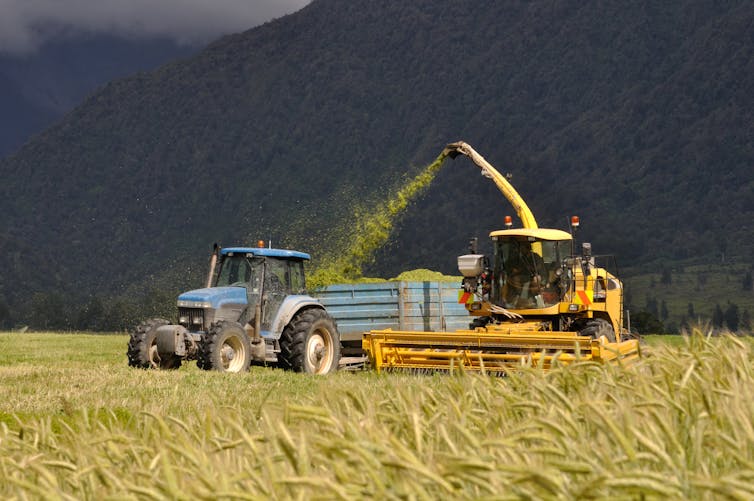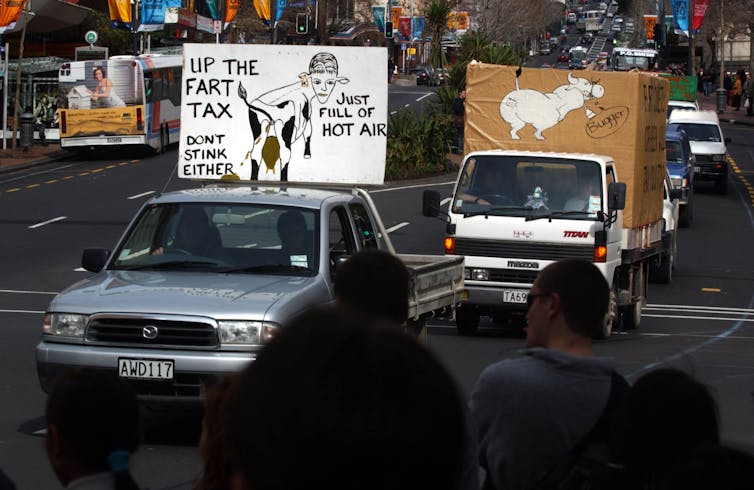By Ralph Sims*
After decades of avoiding inclusion in the Emissions Trading Scheme (ETS), New Zealand’s primary production sector has begrudgingly acknowledged that reducing on-farm emissions of greenhouse gases is an imperative.
Charged by the government with developing a pricing mechanism and strategy as an acceptable alternative to joining the ETS in 2025 under the Climate Change Response (Zero Carbon) Amendment Act, the sector finally released its proposal earlier this month.
Called He Waka Eke Noa, the partnership involves Federated Farmers, Dairy NZ, Sheep and Beef NZ, Horticulture NZ, the Foundation for Arable Research and the Federation of Māori Authorities.
Their recommendations have now been submitted to the government, which has until the end of this year to consider its options. However, numerous uncertainties surround the scheme, which will need to be addressed if it’s to work properly.
Politicians cautious over He Waka Eke Noa farm emissions pricing plan https://t.co/E9T52EFsda
— RNZCountry (@RNZCountry) June 8, 2022
Farm emissions still rising
Since opposing a previous Labour government’s so-called “fart tax” in 2003, many farmers and their representative organisations have resisted inclusion in the ETS while also calling for government assistance to help cope with the impacts of climate change.
In 2015, Federated Farmers claimed voluntary levies had reduced emissions per unit of meat and milk produced by 1.3% a year since 1990 (achieving similar objectives to those of the loathed “fart tax”).
Regardless of these industry and government initiatives, however, annual agricultural emissions have risen 15%, from 34.1 million tonnes of carbon dioxide equivalent (emissions of all greenhouse gas added together) in 1990 to 39.4 million tonnes in 2020 (the latest available data) with no signs of decline.
He Waka Eke Noa recommends all agriculture and horticulture businesses above a certain size should be registered and encouraged to calculate their annual emissions. This will include both short-lived biogenic methane from ruminants and long-lived nitrous oxide from soils, as well as carbon dioxide from fertiliser manufacture (though fossil fuel emissions aren’t included).
A split-gas levy will then be charged, but at a much lower price per tonne than all other sectors are being charged under the ETS. The levy would increase each year, with its price determined by a “systems oversight board”.
Typically the annual levy, as proposed for a large dairy, sheep or beef farm, could exceed NZ$30,000, whereas it might be only $100 for an orchard, based on synthetic fertiliser use.

Doubts and uncertainties
In order to reduce their annual emissions and hence the levy paid, the intention is that farm businesses will have an incentive to use carbon mitigation technologies and introduce forest sinks on their property.
Fossil fuel energy inputs are already covered under the ETS so have been excluded. Unfortunately, this prohibits any incentives being applied for reducing diesel consumption by improving the efficiency of machinery, displacing coal and gas used for heating, or even generating renewable electricity from solar, wind, micro-hydro, crop residues or animal waste resources available on the farm.
He Waka Eke Noa analysis points to a reduction of agricultural emissions of just a few percent by 2030 from both the uptake of new technologies and farm forest sequestration.
Assumed total administration costs of around $120 million to $130 million will be necessary to achieve an annual emissions reduction of about two million tonnes of carbon dioxide equivalent by 2030 if successful. Such an annual reduction should be ongoing, although the levy prices charged are yet to be determined.
Therefore the overall cost measured in terms of dollars per tonne of carbon dioxide avoided, and the revenue to be obtained from the levy for investment in research and development, are not known.
There are numerous other uncertainties. What percentage of farm businesses will register, calculate their emissions and then dutifully pay the levy? What happens to those who don’t wish to take part? Who will monitor the accuracy of their annual submissions and using what methods?
It has been acknowledged that much trust in the farming community will be involved.

Unanswered questions
Furthermore, what happens when no more suitable, low-grade land is available for forest sequestration? Planting trees can only be a short-term measure to buy time before having to reduce domestic carbon emissions more stringently.
Under the ETS, the minimum land area for registering a forest sink is one hectare, so the carbon uptake can be measured and monitored. How will numerous small areas of trees on thousands of farms be monitored, and future carbon loss from harvesting, storm damage or fire accounted for?
Areas of mature indigenous forest are in carbon balance so they cannot sequester more carbon. However, if the trees have been damaged by stock or pests whose removal allows some regrowth, how will this be measured in practice?
Perhaps the main question to ask is, given the relatively low prices likely to be applied per tonne of emissions, how many mitigation technologies will prove economic to implement?
For example, if the 2030 levy price on methane is $15 per tonne of carbon dioxide equivalent, whereas the cost of mitigation strategies (such as using seaweed additives in cow feed) comes in at $20, then why would a dairy farmer bother?
‘Dead rats’ to swallow
Ultimately for a farm business it will be a balancing act between costs and achieving emission reduction goals. As the Climate Change Commissioner has said:
Agricultural emissions pricing needs to achieve emissions reductions – but if implemented poorly it also has the potential to create financial hardship for farmers as they transition to low emissions.
And in the words of the president of Federated Farmers:
Like all of these types of agreements with many parties involved, there’s always going to be a couple of dead rats you have to swallow.
So whether the ministers of climate change and agriculture will swallow a dead rat or two and accept these industry recommendations – with all their uncertainties and lack of high ambition – remains to be seen.
Or will the primary sector be made to join the ETS after all? If so, the fart tax might have been a better outcome for farmers in the first place.![]()
*Ralph Sims, Emeritus Professor, Energy and Climate Mitigation, Massey University
This article is republished from The Conversation under a Creative Commons license. Read the original article.
18 Comments
If reducing Methane is the fastest way to reduce warming, then my contention is the government needs to pay farmers incentives , as well as tax those that don't change , or increase their outputs.
Of course, there is also Methane form landfill and sewage plants that must be dealt with . Every landfill and sewage plant should have methane capture and use as part of its consent.
I suggest you have a read of some of these links to find out where rising methane levels are coming from (hint, it's not NZ livestock).
https://mississippitoday.org/2022/06/19/petal-gas-storage-sends-half-to…
https://interestingengineering.com/worlds-largest-methane-gas-leak
https://www.washingtonpost.com/climate-environment/2022/06/08/oil-gas-m…
https://www.cnbc.com/2022/02/24/plugging-methane-leaking-oil-gas-wells-…
https://www.abc.net.au/news/2022-06-08/coal-methane-leaks-double-offici…
https://www.theguardian.com/world/2022/jun/15/methane-leak-at-russian-m…
https://www.france24.com/en/live-news/20220612-climate-offshore-methane…
About that uncertainty. This tax on farming is a particularly callous farce.
"The past three decades have seen prolonged periods of increasing atmospheric methane, but the growth rate slowed in the 1990s (1), and from 1999 to 2006, the methane burden (that is, the total amount of methane in the air) was nearly constant. Yet strong growth resumed in 2007. The reasons for these observed changes remain poorly understood because of limited knowledge of what controls the global methane budget (2)."
"Large fluctuations in the growth rate of atmospheric methane are also observed from one year to the next2, but their causes remain uncertain2,3,4,5,6,7,8,9,10,11,12,13. Here we quantify the processes that controlled variations in methane emissions between 1984 and 2003 using an inversion model of atmospheric transport and chemistry. Our results indicate that wetland emissions dominated the inter-annual variability of methane sources, whereas fire emissions played a smaller role, except during the 1997–1998 El Niño event."
https://www.nature.com/articles/nature05132
https://www.science.org/doi/10.1126/science.1247828
New Zealand needs to drastically diversify the economy.
It's certainly not the team of 5 million who are creating ALL the emissions of NZ farmers. If farmers are producing for 40 million people, and the blame falls to New Zealand for those emissions, I calculate 35 million consumers abroad who also should be paying for the emmissions produced in the production AND transport required. Too often they receive better prices for the products they consume from New Zealand, and local consumers cop significantly higher prices to supplement keeping export prices low, just so exporting businesses can remain competitive.
Let's also not ignore the environmental impact to the health of the local population through the degradation of the natural environment eg rivers, streams, desertification etc that those 35 million people have on NZ. Free trade can be, and often is, a curse for local consumers, their natural environment and their economy. Let's not even consider how many farms are no longer New Zealander owned and resident businesses eg not full tax paying entities because...dodgy trust structures.
The increased production and expanded capacity from mines is on track to add 10 percent to worldwide emissions of coal methane, threatening to undermine international efforts to tackle global warming, according to a recent estimate by Global Energy Monitor, a nongovernmental organization that tracks fossil fuel projects.
https://www.washingtonpost.com/world/2022/05/27/china-methane-coal-clim…
All the cool kids are doing it. "Dutch join Germany, Austria, in reverting to coal". It is high time Ardern admitted her climate homeopathy leadership policy is leading no one and changing nothing. Restrictive natural gas and intermittent energy policies are making the world's poor suffer, increasing air pollution and decreasing food supply/export receipts.
https://www.france24.com/en/live-news/20220620-dutch-join-germany-austr…
profile,
Unlike you, I have no doubt about the reality/severity of anthropogenic climate change, but I have consistently argued that the apparent widespread support for measures to combat it would not survive threats to people's current standard of living. Indeed, even without that, we are not about to surrender our dependence on fossil fuels anytime soon. A report from Ren2, renewables now(part of the UN Environment programme) makes this very clear. One quote will suffice; "Although many more governments committed to net zero greenhouse gas emissions in 2021, the reality is that, in response to the energy crisis, most countries have gone back to seeking out new sources of fossil fuels and to burning even more coal,oil and natural gas".
In the face of that, it is perfectly reasonable to ask what NZ should do? Nothing we might do will move the global dial on emissions, so should we do little/nothing? I doubt if that would be acceptable, morally or practically, but equally, to put our economy at considerable risk just to look good makes no sense. On that, i think you and I would find agreement.
Yes we are part of the world, which is why we need to ask "would shutting down New Zealand's highly carbon efficient farmers for the purpose of tackling climate change increase or decrease total global carbon emissions?" The answer of course is increase, because there is high demand for animal products so our production would be taken up by grain feeding farmers, or Brazilians cutting down some more Amazon rainforest.
Don't exaggerate , The planned reductions are nowhere near Shutting farmers down .We are talking 5 -10 % , an amount that could easily be surpassed by better returns for been a good boy , and massively surpassed if we lose our EU etc markets for been a bad boy.
NZ's 10 % reduction of its 0.5% contribution to the worlds food supply would likely be met (if noticed) by moving to more plant based protien , a move underway anyway .
Lets get real , we are a very small fish in a very big pond, our reductions might mean little , but we could easily be wiped out by negative publicity.
The start of the oligarch class using the government puppets to financialize carbon. Control is the order of the day, want to fly to Aussie, sorry you do not have enough carbon credits but you can buy some from Bill Gates. Why do you think he is buying up all the land in the USA, because he wants to feed the poor, through his feel good (tax exempt) foundation? Just like he saved everyone from Covid in co-hoots with the WHO, the CDC and FDA. Even more " Foolaid". The green initiative is the new Psychosis, the vaccinated angels are over the 'Covid" scam.
Government will have to print a bunch more money, to 'save the planet'.





We welcome your comments below. If you are not already registered, please register to comment.
Remember we welcome robust, respectful and insightful debate. We don't welcome abusive or defamatory comments and will de-register those repeatedly making such comments. Our current comment policy is here.